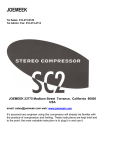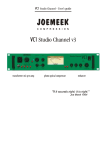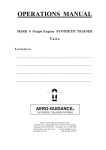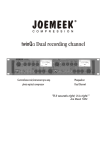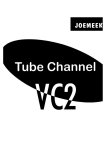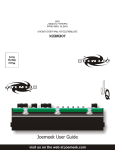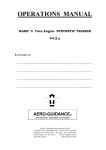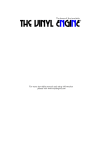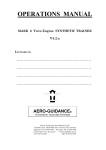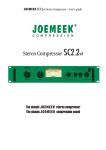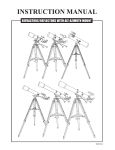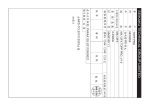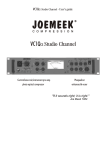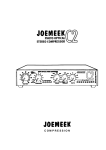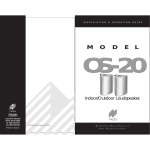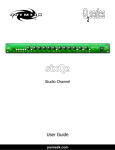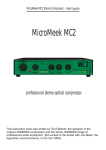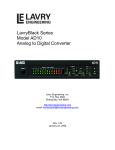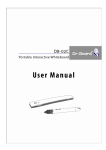Download Stereo Compressor SC4
Transcript
C O M P R E S S I O N Stereo Compressor SC4 STEREO COMPRESSION, PERFECT STEREO IMAGING, DIGITAL AND ANALOGUE FLEXIBILITY User's Guide - The SC4 Stereo Compressor delivers perfect stereo imaging and control, classic JOEMEEK sound, and complete analogue and digital flexibility to recording studios, broadcasters and post production suites. SC4 M&S DAD Stereo Compressor - User's guide INSTRUCTION BOOK CONTENTS JOEMEEK SC4 OVERVIEW 3 SC4 MAIN FEATURES - The analogue compressor section 4 - The digital interfaces 5 THE JOEMEEK COMPRESSOR - Why it sounds the way it does 6 - 'Mimic' Rock concerts 7 - Time 8 CONTROLS AND INDICATORS 9 INPUTS AND OUTPUTS 11 TECHNICAL SPECIFICATION 12 SAFETY, WARRANTY 13 Ted Fletcher This instruction book was written by Ted Fletcher; the designer of the original JOEMEEK compressor and the whole JOEMEEK range of professional audio equipment. Ted worked in the studio with Joe Meek, the legendary record producer, in the mid 1960s. SC4 2 SC4 M&S DAD Stereo Compressor - User's guide JOEMEEK STEREO COMPRESSOR SC4 OVERVIEW THE SC4 .... A NEW STANDARD In 1994 the first Joemeek stereo compressors were introduced to a few discerning producers and studios in London and New York. They were an immediate success and quickly became standard equipment for getting 'alive' sounds on individual instruments; particularly drums, and over the whole mix. Since 1994 a digital revolution has taken place and now, whether admitted or not, most commercial sound is recorded and processed on hard disks and in computers. But there's one area where a digital solution cannot be found; and that's in the subtle areas of effects compression, and that's where the Joemeek compressor reigns supreme. The new SC4 brings the Joemeek compressor fully up to date with the addition of a super quality yet flexible digital interface, and the introduction of some new features to make working in the digital domain even easier. In the Joemeek studio, we have been experimenting with 'sum and difference' (or 'MS') recording and processing; this is a technique where a stereo signal is changed to sum and difference, the 'sum' representing the loudness, and the 'difference' representing the stereo image information. Applying this to compression, we found that it significantly improved the stereo imaging and completely eliminated any image shift problems that sometimes occur with all types of stereo compressor. A by-product of the revolutionary MS matrix coding and decoding used in the SC4 is the ability to use it as a coder/decoder, and to access the stereo audio in 'Middle and side' mode; a function of increasing importance in sound production using special effects. SC4 3 SC4 M&S DAD Stereo Compressor - User's guide SC4 Main Features 1) THE ANALOGUE COMPRESSOR SECTION The SC4 IS a Joemeek SC2 stereo compressor with additional features: The analogue inputs are balanced via XLR connectors, at line level, and the input gain control can add gain up to a limit of 18 dB. After the input stage, the audio is converted to 'middle and side' mode, this means that one channel contains the 'volume' (sum) information, while the other contains the 'width'(difference) information. A front panel switch disables the MS coder so that either analogue or digital signals in MS mode can input directly. On the rear panel two Jack sockets give insert access to the 'middle' and 'side' audio signals. This is so that special effects can be introduced by processing the width information independently of the volume information. The signals go through the compression circuits where a non-linear sidechain drives light sources, and the actual compression is done with photo-resistors. This is the heart of the Joemeek sound. Because of the difficulties in achieving a true hard-wired 'bypass' switch (especially with digital), the 'compression in/out switch has the additional facility of switching in extra gain to allow for the compression effect. Although the amount is only 2dB, this makes the comparison 'compressed/uncompressed' switch very much more useable. Metering is unconventional: The left hand meter reads the volume information in the stereo signal, the right hand meter reads the compression depth in real time. After compression, the 'side' channel goes through a separate variable amplifier giving a 'width' control. This affects the stereo image so that it is variable all the way from 'mono' out to 200% stereo. SC4 4 SC4 M&S DAD Stereo Compressor - User's guide A detented output gain control is calibrated to give 6dB gain in hand and the MS signal is then decoded back into stereo left and right. The analogue output stage gives balanced outputs via XLR connectors. 2) THE DIGITAL INTERFACES (optional on some SC4 models) Digital inputs are either optical or AES/EBU, at 44.1 or 48 KHz samplerate. Digital to analogue conversion is to 24 bit standard. The input to the compressor section is switchable between the analogue inputs and the digital inputs. After compression and the analogue output gain control, the decoded audio signal drives both the analogue output stages, and the analogue to digital converters. The clocking of the digital output is selectable: A 'local/remote' switch selects whether the output follows the incoming clock or generates a local clock. Another select switch determines the local clock setting; 44.1 or 48KHz. LEDs show the selected samplerate but they are only illuminated when the selector is in 'local' mode, or when there is no incoming clock. When an incoming clock is present, it is indicated by a red LED on the front panel. Digital outputs are AES/EBU and optical (SPDif) with an additional pushbutton on the rear panel which switches 'consumer' or 'professional' mode. SC4 5 SC4 M&S DAD Stereo Compressor - User's guide TIE JOEMEEK COMPRESSOR WHY IT SOUNDS THE WAY IT DOES Conventional compressors used to be called 'levelling amplifiers'. They were designed originally to reduce the dynamic range of all program material so that it would record properly onto media that had limited range such as optical film and vinyl disc. As an engineering tool the compressor had to work in as linear a manner as possible and to be as unobtrusive as possible, so the attack characteristic (that is the way the changes in volume take place) had to be smooth, and the release (how the gain recovered when the audio signal was removed) needed to be long. While experimenting with levelling amplifiers, engineers found that the application of compression had an effect on the perceived sound of music. The changes were subtle but definite. Equipment manufacturers over the years have tried to combine the requirements of engineers and produce compression devices which are both usable as levelling amplifiers and as effects units. This has been a completely wrong approach and has only served to create bad reputations for a number of products because, although they behave beautifully as engineering devices, they actually sound unmusical. The JOEMEEK compressor is the first device commercially available to have been designed purely as an effects compressor. Its purpose is to change the way the ear perceives the sound; its action changes the clarity, balance and even rhythmic feel of music. DYNAMICS The human ear has a fantastic dynamic range; it hears and can interpret sounds from as low as a pin dropping, up to being next to a pneumatic drill. In fact, there are mechanisms in hearing which act as 'levelling amplifiers' and allow us to be able to hear and interpret this extreme range. When very loud music is heard, there are two main mechanisms that allow us to make sense of the sounds. These are real biological compressors; the first one in 'software' affecting the way the brain interprets signals from the inner ear, the second is 'hardware' in the way the electrochemical impulses are passed from the inner ear. First there is a 'software compressor' in the brain that softens the effect of the loud sounds. This effect is fast acting and not long lasting. It acts over the whole frequency range and its effect is to soften the very loud peaks of noise or sound, if the sound is removed or stopped suddenly, then your 'ears' (actually your brain) recovers in just a couple of seconds to full sensitivity. Because we all live with the effect all our lives, it is rarely noticed. SC4 6 SC4 M&S DAD Stereo Compressor - User's guide MIMIC The JOEMEEK compressor mimics this effect and instead of the listener's ear and brain doing the compression, the JM pulls down the sound at precisely the right moment and amount to fool the ear into thinking that the sound is louder than it actually is. But doesn't any compressor do that? Actually no. Although there are many compressors on the market that can be set to the correct time constants to mimic the effect, the actual gain reduction is never done properly. The problem is that the human ear is not an engineering device, it's non-linear in all respects. The psychoacoustic compression effect is like turning down the volume for an instant; but once there, the relative volumes of sound are NOT affected further. Good Engineering Practice says that a compressor should work logarithmically; for a certain increase of volume, the output volume should rise proportionally less: That is, for a 2:1 compressor, an increase of volume of 10dB at the input should produce only 5dB increase at the output, a continuous process where the more you put in, the more it's pushed down. The JOEMEEK compressor just doesn't work that way. As volume increases at the input, a point is reached where the compressor starts to work and the gain through the amplifier is reduced. If the input level keeps rising, gradually the gain reduction becomes LESS effective and the amplifier goes back to being a linear amplifier except with the volume turned down. And this is precisely how the human ear behaves! So the 'ear' is fooled into thinking that the JM compressed sound is louder than it really is; but without the strange psychoacoustic effect of 'deadness' that all other compressors suffer from. ROCK CONCERTS The second form of compression in the human ear is mostly mechanical. It involves certain parts of the inner ear being suppressed so that they do not respond to the large vibrations caused by loud noise. The effect is much slower to take effect and can take days to recover. This is the familiar 'deadening' effect that we all get in extreme cases when going to a rock concert. One of its effects is to change the way that we perceive different frequency ranges. Basically, the louder the sound, the more we hear of the HF and LF parts because our sensitivity to the mid ranges is reduced. The JM compressor, because of its bendingof the loudness contours has already fooled the ear into thinking that the sound is louder than it really is; the bonus is that the mid ranges seem to jump forward and the clarity improves because the mechanical changes that the brain thinks have taken place in the inner ear, have not happened. With conventional compressors the 'fooling' effect is not so complete and the ear perceives something that is not quite right. SC4 7 SC4 M&S DAD Stereo Compressor - User's guide Consequently, this additional clarity is missing and the whole effect is one of muddy deadness.Some historic compressors from the 1950s were used creatively by Joe Meek and other notable engineers of the past. They achieved some of these effects and the compressor models have become venerated for their 'sound'; the JOEMEEK compressor achieves more, and does it by design. TIME Of course the JoeMeek compound compression curves tell only part of the story. There are also the time constants of attack and release which have enormous effect on the musicality of the sound. The attack time produces audio 'punch' that again is a psychoacoustic effect, different attack times mimicking different levels of human biological compression. Release time is even more important to maintaining illusion; the JM compressor uses a compound release circuit that reacts quickly to short bursts of volume, and less quickly to sustained volume, this helps to maintain the transparency of the sound. SC4 8 SC4 M&S DAD Stereo Compressor - User's guide CONTROLS AND INDICATORS INPUT GAIN CONTROL is a rotary pot controlling the gain of both the analogue and the digital inputs to the compressor. The range of the control is from fully off, to a system gain of 18dB (with the output gain control at its callibration point). SLOPE is a FIVE position rotary switch which can be thought of as a ratio control, but actually changes the shape of the compression curve. It also sets the maximum amount of gain reduction in the system and has the effect of hardening or softening the compression. At position 1 the compression effect is small and the ratio low. At position 5, the compressor is approaching limiting; the ratio is about 8:1 at operating level, but less than this at low levels and during overload peaks. DIGITAL IN is a push button switch which enables the audio path from the D/A converter. A yellow LED indicates that the digital input is live. M/S INPUT is a push button that disables the internal M/S coder. In this mode, the output of microphone amplifiers with M/S microphones attached (or M/S recordings) can be directly connected to the SC4. COMPRESSION is a rotary control setting the amount of drive to the compressor sidechain. The range is from off to maximum compression. ATTACK is a rotary control setting the rate at which the compressor starts to operate. At fully anticlockwise, the attack time for transient compression can be as low as 0.5 milliseconds. The total range is about 6 milliseconds. RELEASE is the control which sets the time for any gain reduction to return to "off state. IN/OUT is a push button switch to disable the compression sidechain for comparisons between compressed and uncompressed signals. A blue LED indicates that the compression sidechain is active. A RED LED shows that the compressor section is bypassed. A 2dB gain adjustment is built in so that it is easier to compare compressed and uncompressed signals. SC4 9 SC4 M&S DAD Stereo Compressor - User's guide The VU meters read stereo volume level (LH meter) and compression depth (RH meter). WIDTH is a rotary control affecting the 'side' channel which contains the width information. At fully anticlockwise the stereo signal becomes mono. at full clockwise, the width information is 100% greater than in the normal stereo image (200%). The calibration point in the centre is normal stereo. OUTPUT GAIN is a rotary control which sets both the analogue and the digital output level from the compressor. It is calibrated so that at the '0' mark, the noise and overload conditions are optimised. With the INPUT GAIN control set at its calibration mark as well, the through gain is unity. 6dB of make-up gain is possible with the control. LOCAL/REMOTE SYNC push button selects whether to follow external or internal clock. The button is only active when there is a digital source connected. SAMPLERATE push button sets the internal clock to 44.1 or 48KHz. EXT SYNC LED illuminates when a digital input is present. Samplerate LEDs show the selected frequency. They are only alight when the local onboard clock is active. On the rear panel there is a single push-button. When out, the digital output is in 'consumer' mode. This is correct for optical (SPDif) operation. When the button is depressed, the mode is changed to 'professional' which may be required for some equipment when using AES/EBU. The 'consumer' protocol with no pre-emphasis is most generally recognised and universally operational in audio. The copy protect bit stays set to 'copy OK'. The 'AES/EBU' input and output may be used directly with SP-Dif systems by using a converter cable. Make sure that when converting from XLR to RCA phono, the screen of the cable connects to both pin 1 and pin 3, the conductor connects to pin 2. SC4 10 SC4 M&S DAD Stereo Compressor - User's guide INPUTS AND OUTPUTS ANALOGUE INPUTS Line inputs are 20Kohm floating balanced via XLR connectors maximum level is approx +28dBu. ANALOGUE OUTPUTS Line outputs are XLR connectors 75 ohm source impedance, auto-centreing balanced. Maximum output +26dBu. INSERT An unbalanced port is provided so that additional analogue circuits may be inserted into the sum and difference (MS) path. The 'tip' is the buffered analogue output of the MS coder the 'ring' is the input of the compressor DIGITAL INPUTS AND OUTPUTS All digital connections DC isolated from analogue systems. TOSLINK Optical inputs and outputs. AES/EBU XLR input and output. POWER Power input is 230 or 115VAC at approx 12 watts. Voltage selection is by rotating the fuseholder. NOTE. Operation of the compressor on the wrong mains voltage WILL CAUSE TERMINAL DAMAGE. SC4 11 SC4 M&S DAD Stereo Compressor - User's guide TECHNICAL SPECIFICATION ANALOGUE SIGNAL PATH INPUTS : XLR connectors. Floating electronic balanced inputs 20Kohm impedance. INSERT : unbalanced 1/4 inch jack.10Kohm nominal -10dB, source impedance 400 ohms. OUTPUTS : Main analogue outputs XLR connectors. Auto centering electronic balanced. Source impedance 75 ohms. AUDIO PERFORMANCE AMPLITUDE FREQUENCY RESPONSE : +0 -1dB 7Hz to 30KHz (analogue path) +0 -1dB 10Hz to 20KHz digital path. HARMONIC DISTORTION : less than 0.01% at all frequencies and levels except under compression where 2nd harmonic distortion is generated by the compression. MAX. OUTPUT: +26dBu NOISE : less than -84dBu (dynamic range exceeds 110dB) DIGITAL SIGNAL PATH .INPUTS AND OUTPUTS (optional on some models) AES/EBU and TOSLINK OPTICAL. CONVERSION PERFORMANCE : A/D 1 bit system producing 24 bit word at 128 times oversampling. D/A 24 bit word capacity. 128 times oversampling. Analogue performance limited at high frequency by sample rate. At 48KHz, system is 1 dB down at 22.5KHz. Dynamic range capability : 115dB. SC4 12 SC4 M&S DAD Stereo Compressor - User's guide SAFETY The unit complies fully with European Cenelec requirements (CE) and may be used in all territories subject to safety approval of the power supply to local regulations. WARRANTY In the unlikely case of a breakdown, please return the unit and power supply in its original packing through the supplier. The unit will be attended to immediately and returned to your supplier. If any breakdown occurs (excluding physical mistreatment) within 12 months of purchase, no service charge will be made. Manufactured by; FLETCHER ElectroAcoustics Ltd. Quay House, Quay Road, Newton Abbot, DevonTQ12 2BU Tel:+44 1626 333948 Fax:+44 1626 333157 e-mail [email protected] DECLARATION OF CONFORMITY This analogue audio processing equipment conforms to the standards and requirements of the European Economic Community. The EC Harmonised standards that have been applied are; a) Electrical equipment (safety) Regulations 1994 (S.I. 1994/3260) b) Electromagnetic Compatibility Directive (89/336/EEC) incorporating (S. I. 1992/2372) "If it sounds right; it is right" Joe Meek 1964 SC4 13













